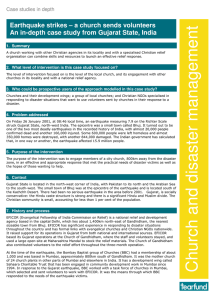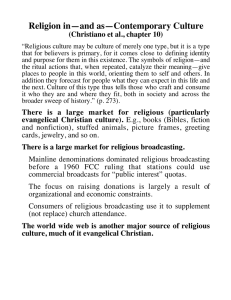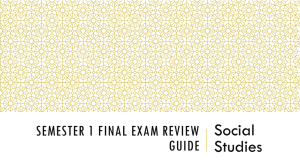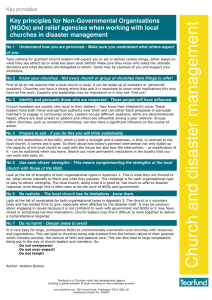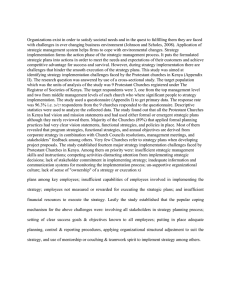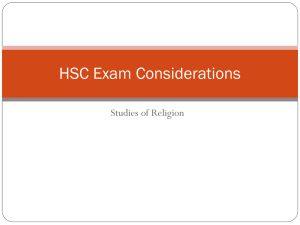W O R K I N G Many Faiths of Many
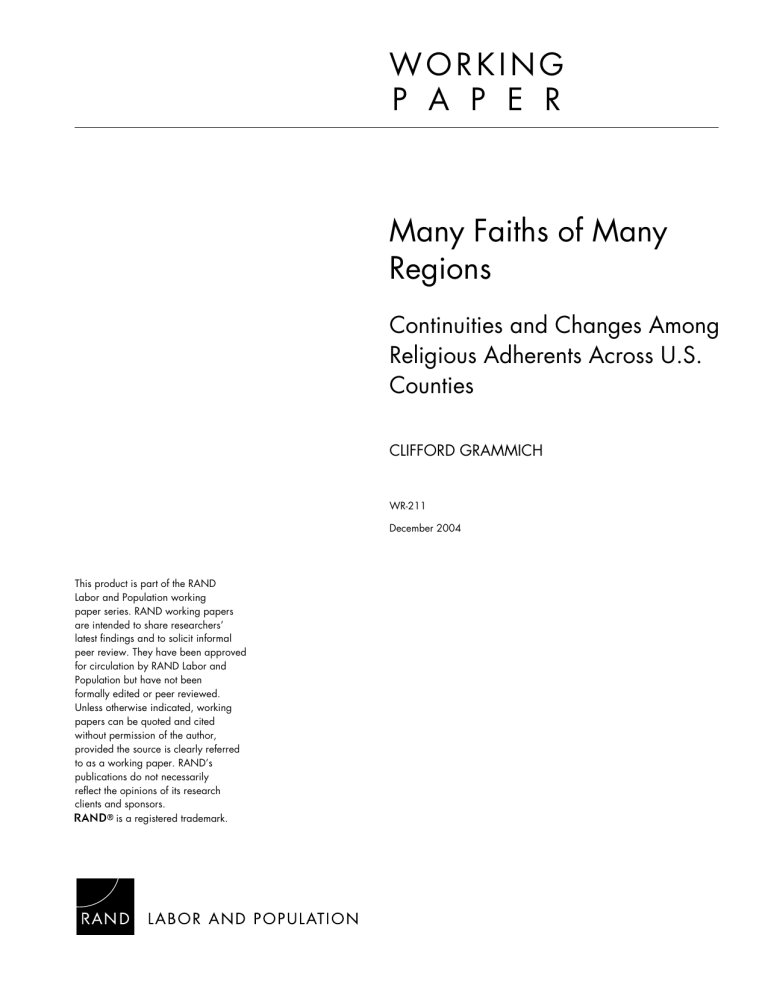
This product is part of the RAND
Labor and Population working paper series. RAND working papers are intended to share researchers’ latest findings and to solicit informal peer review. They have been approved for circulation by RAND Labor and
Population but have not been formally edited or peer reviewed.
Unless otherwise indicated, working papers can be quoted and cited without permission of the author, provided the source is clearly referred to as a working paper. RAND’s publications do not necessarily reflect the opinions of its research clients and sponsors.
is a registered trademark.
W O R K I N G
P A P E R
Many Faiths of Many
Regions
Continuities and Changes Among
Religious Adherents Across U.S.
Counties
CLIFFORD GRAMMICH
WR-211
December 2004
Many Faiths of Many Regions: Continuities and Changes Among
Religious Adherents Across U.S. Counties
Clifford Grammich
Abstract
U.S. religious bodies continue to vary by their geographic distribution and their rates of growth. The changing landscape of religious adherence has many implications for communities on myriad issues (e.g., health, policy, social change). An examination of recently tabulated county-level numbers of religious adherents shows Evangelical Protestants continuing to grow, but at slower rates than that of the population. Mainline Protestants continue to decrease, even in areas of some population growth. Catholics are increasing slightly, but likely only because of
Hispanic and immigrant population influxes. Precisely comparable trend data on total Jewish population growth are not readily available, but there appears to have been a considerable redistribution of the Jewish population in recent decades. Earlier county-level on other non-
Christian religions is not available, but recent data show Muslims concentrated in large metropolitan counties and Eastern religious congregations concentrated in counties with Asian populations. I examine these changes and distributions of religious populations in light of existing theories that could account for these variations. The recent results confirm some of these theories, but suggest further examination or possible modifications for others. Further analysis of these data may also yield some insights on the interplay between political and religious population change, as well as on efforts to meet social needs through faith-based institutions.
Introduction
In recent years, religious bodies have varied widely in their rates of growth. Some
Christian religious bodies are encroaching on the traditional areas of others, and all face encroachment from non-Christian bodies, as well as a growing number of persons not affiliated with religious faith.
The growth and geographic redistribution of adherents to varying faiths reflects an interplay of demographic processes with existing “supply side” influences. Through migration,
1
members of particular faiths have dispersed from former regional origins. Immigrant influx has fueled numerical expansion of others. The regional distribution of religious groups also appears to influence their growth (or lack thereof) in several ways.
The changing landscape of religious adherents has many implications for communities.
Past analyses of county and statewide distributions of religious adherence have been analyzed for their influence on abortion rates and politics (Gober, 1994; Wetstein & Albritton, 1995;
O’Connor & Berkman, 1995; Norrander & Wilcox, 1999; Tomal, 2001); crime rates (Olson,
1990; Kposowa, Breault, & Harrison, 1995); divorce rates (Breault & Kposowa, 1987; Sweezy
& Tiefenthaler, 1996); environmental policies (Lowry, 1998); income inequality (Partridge,
Partridge & Rickman, 1998); local public school expenditures (Husted & Kenny, 2000 and
2002), and suicide rates (Ellison, Burr & McCall, 1997; Burr, Hartman & Matteson, 1999). The present religious landscape also appears to have considerable influence on voting and political affiliations, and may affect efforts to meet social needs through faith-based institutions.
In this article, I use county-level data to explore recent change in populations of eight groups of religious adherents across the United States and the compatibility of such change with extant theories. The data portray diversity and the persistence of regional cultures and also the changing fortunes of different groups. The analysis bears on existing theories that account for contemporary change in populations of religious adherents, confirming some and suggesting modifications to others.
The eight groups I examine are (1) Evangelical Protestants, (2) Mainline Protestants, (3)
Catholics, (4) Eastern (a.k.a. Orthodox) Christians, (5) Mormons, (6) Jews, (7) Muslims, and (8)
Other Faiths. In addition to exploring growth or loss among these groups, I review some variations in these patterns. In documenting the most recent local changes and their compatibility with extant theories, I hope to suggest future paths of research on populations of religious adherents.
Background
Many explanations, some competing and some complementary, have been offered for contemporary change in religious populations. Regarding change in Protestant populations, some writers (e.g., Kelley, 1972; Roof & McKinney, 1987) have claimed comparative
Evangelical strictness in doctrine and practice has led to comparative growth, as the faithful
2
flock to and value most those bodies where adherence might be viewed as having higher (but not unreasonable) costs and presumably corresponding benefits. Others (e.g., Shibley, 1996) suggest that strictness, in itself, does not lead to Evangelical growth, but that such growth, particularly outside the South, is more likely among churches that can adapt to local needs. Other more general theories (e.g., Finke & Stark, 1992) focus not as much on theology as on religious market innovation. One demographic explanation (Stump, 1999) suggests theologically conservative churches are better positioned in areas of population growth.
Conversely, one recent analysis (Hout & Fischer, 2002) of religious populations suggests losses stemming from demographic variables (e.g., growth among populations such as young adults who traditionally have lower levels of religious adherence) and political variables (e.g., disaffiliation in the wake of growing politicization of a religious body). Many also point to growing secularization, i.e., an indifference to or rejection of religion, as a possible cause for decreasing populations of religious adherents, though measuring such a universal variable on a local level such as counties is difficult if not impossible. (In addition, Chaves, 1994, notes secularization if viewed not as a decline not of religion but of the scope of religious authority can be compatible with stable religious adherence.)
Data
To examine the most recent changes in religious populations on a local level, I use the most recent data on religious populations from the Association of Statisticians of American
Religious Bodies (ASARB). Coinciding with the decennial federal census, the ASARB compiles self-reported county-level enumerations of religious congregations and their adherents in the
United States. Religious Congregations and Membership in the United States ( RCMUS 2000 ) is the fifth in a series of such studies dating from the 1950s (Whitman & Trimble, 1956; Johnson,
Picard & Quinn, 1974; Quinn et al., 1982; Bradley et al., 1992; Jones et al., 2002). The series provides rich detail on religious populations in communities of varying sizes and for religious bodies of all sizes. The data have long been recognized for their consistency and validity.
The 2000 enumeration includes tabulations of religious congregations (e.g., churches, synagogues, mosques, or temples) and adherents (i.e., full members, their children, and other participants not considered members). The proportion of the total population represented in the
3
study, 50.2 percent, is within the range of previous studies representing 47 to 55 percent of the population.
The series has certain limitations. The data refer to participating bodies only, not all religious adherents in the United States. It is impossible to determine the exact level of coverage of all religious adherents, given the unknown size of that population. Some evidence suggests that the number of adherents reported in 2000 represents nearly two-thirds of the population of religious adherents. (Kosmin, Mayer & Keysar report that 80 percent of U.S. adults claimed religious affiliation in 2001. Davis & Smith, annual, report that 85 percent of U.S. adults claimed religious affiliation in 2000. Research by Cieslak, 1995, indicates that, at least in the case of the Catholic Church, survey estimates of religious adherence may overstate actual adherence by at least one-tenth.)
The series undercounts particular groups (e.g., predominantly African American religious bodies) and regions. This problem may have diminished over time. An evaluation of the series through 1990 noted that while the effort originally “was met with some skepticism about how reliably religious institutions assemble their statistics[,] it is now clear that these [data] offer a considerable level of internal consistency and comparability” (Newman & Halvorson, 1993, 60).
The groups I analyze are based on the classifications of the American Religion Data
Archive ( www.thearda.com
) and its scheme based on research of Steensland et al. (2000),
Melton (1999), and Mead (1995). I also classify Jews, Muslims, and the Church of Jesus Christ of Latter-Day Saints as their own categories, rather than with “Other Faiths.”
The “Evangelical Protestant” and “Mainline Protestant” groups encompass a broad range of theologies, thereby blurring important distinctions. Nevertheless, churches within these groups share many common characteristics. Evangelical Protestants “have typically sought more separation from the broader culture, emphasized missionary activity and individual conversion, and taught stricter adherence to particular religious doctrines,” while Mainline Protestants “have typically emphasized an accommodating stance toward modernity, a proactive view on issues of social and economic justice, and pluralism in their tolerance of varied individual beliefs”
(Steensland et al., 2000, 293-94).
The Catholic grouping includes both the predominant Latin church and Eastern Catholic churches (e.g., Armenian, Byzantine Ruthenian, Chaldean, Maronite, Ukrainian) in communion with it (and reported as a single total in the data). The Jewish estimate, unlike the data on
4
institutional adherents for most Christian groups, represent the entire Jewish population in the
United States and does not differentiate among different traditions (e.g., Orthodox, Conservative,
Reform, etc.). The Muslim data are based on a survey of known mosques. The “Other Faiths” category includes all remaining religions, most of which are Eastern bodies for which only temple counts are available.
Overview of Patterns
Catholics and Evangelical Protestants are the two largest groups of religious adherent populations (Table 1). Prevalence of groups differs by region. Evangelical Protestants, Mainline
Protestants, and Mormons are more prevalent in non-metropolitan counties; those of other faiths are more prevalent in metropolitan ones.
Table 1--Adherence by Region
Evangelical Mainline
Protestant Protestant Catholic
Eastern
Christian Mormon Jewish Muslim
14.2% 22.0%
Metropolitan 12.0 8.5
Non-metropolitan 23.0 13.0
24.3
12.7
North Central 12.8 13.5
38.5
22.5
12.3
23.2
0.3%
0.3
0.1
0.6
0.3
0.1
0.2
1.5% 2.2%
1.4
2.0
2.7
0.1
0.3
0.4
0.6
5.1
5.3
1.1
1.3
2.1
0.5
Other
Faiths
0.7 0.1
0.0 0.1
0.1
Total
50.2%
50.1
50.9
Evangelical Protestants are nearly twice as prevalent in the South as elsewhere. Mainline
Protestants are more prominent in the North Central states. There are more Catholics in the
58.7
51.1
49.2
43.8
Northeast than all other groups combined. Catholics and Jews are about twice as prevalent in the
Northeast as elsewhere.
County-level patterns (Map 1) display long-standing concentrations noted in previous analyses (e.g., Newman & Halvorson, 1984; Zelinsky, 1994). Evangelical Protestants are the leading religious group in 1,585 of 3,141 counties nationwide. Catholics outnumber other
5
groups in 841 counties, including those in the Northeast, Southwest, and long-standing Catholic communities in south Louisiana as well as many rural upper Midwest counties where earlier high fertility rates helped make them the leading group (Beale 1990). Mainline Protestants are the leading group in 639 counties, primarily in the North Central states, but also in places (e.g., West
Virginia) where the Civil War led many Protestants to separate from their Southern brethren.
Mormons are the leading group in 71 counties centered on Utah. Orthodox Christians are the leading group in three Alaska county equivalents, and Muslims are the leading group in an independent city of Virginia.
Map 1—Leading Religious Group by County
6
Evangelical Protestants
Evangelical Protestants include more than three in five Protestants enumerated. Given that many classifications, including that of the American Religion Data Archive, include predominantly African American bodies in this group, these data likely represent an undercount of it. Evangelical Protestants exceed 40 percent of the population in Alabama, Arkansas, and
Oklahoma, as well as in many counties of Georgia, Kentucky, north Louisiana, Tennessee, and north Texas (Map 2).
Map 2—Evangelical Protestants by County
The Southern Baptist Convention is, by far, the largest Evangelical Protestant body, accounting for half of this population. The six largest Evangelical Protestant bodies (considering independent, non-denominational Christian churches of at least 300 members as a single religious body) constitute 75 percent of this population (Table 2).
7
Table 2--Leading Evangelical Protestant Bodies
Churches Adherents Counties*
Adherents as % of group total
Southern Baptist
Assemblies of God
Lutheran Church--Missouri Synod
Independent, non-denominational**
41,514 19,881,467
11,880 2,561,988
6,077 2,521,062
1,705 2,051,937
2,670
2,616
1,801
576
49.8%
6.4%
6.3%
5.1%
Churches of Christ
Christian Churches and Churches of Christ
Other Evangelical Protestants
13,027 1,645,584
5,471 1,439,253
60,183 9,829,574
2,429
1,600
2,896
Total 139,857 39,930,865
*Total counties for all Evangelical Protestants represents number of counties with any such church.
4.1%
3.6%
24.6%
**Of at least 300 members; for more information, see Jones et al., 2002, Appendix D.
Evangelical Protestant population types vary by region (Table 3). Southern Baptists are most prevalent in the South, but elsewhere adherents of denominations with fewer than one million adherents (not listed individually) are more prevalent.
Table 3--Evangelical Protestant Adherence by Region
Southern Baptist
Assemblies of God
Lutheran Church--Missouri Synod
Independent, non-denominational
Churches of Christ
Christian Churches and Churches of Christ
Other Evangelical Protestant
Northeast
North
Central South West Nation
0.21% 2.54% 17.03% 1.69% 7.06%
0.54% 0.92% 0.96% 1.13% 0.91%
0.28% 2.57% 0.39% 0.35% 0.90%
0.25% 0.66% 0.87% 0.99%
0.06% 0.34% 1.21% 0.28%
0.73%
0.58%
0.07% 1.09% 0.47% 0.38% 0.51%
1.96% 4.69% 3.72% 3.21% 3.49%
Total 3.36% 12.80% 24.64% 8.03%
While the Evangelical Protestant population continues to increase, growth for four of its six largest bodies has been slower than that for the population as a whole (Table 4). Such lower
8
growth rates (or losses) may suggest assumptions regarding the appeal of conservative theology merit re-examination.
Table 4--Growth (or Loss) in Populations of Evangelical Protestants, 1990-2000
Southern Baptist
Assemblies of God
Lutheran Church--Missouri Synod
Independent, non-denominational
Churches of Christ
Christian Churches and Churches of Christ
Total Population
Northeast
North
Central South West
32.6% 2.2% 5.9% -6.1% 5.0%
11.4% 15.6% 17.7% 25.5% 18.5%
-10.0% -3.2% 1.8% -5.0% -3.2%
-2.3% -16.3% 4.5% 18.9% 2.5%
-16.2% -6.0% -0.3% -6.1% -2.1%
4.1% 16.2% 18.8% 28.9% 18.6%
5.5% 7.9% 17.7% 19.7% 13.3%
Other theories (e.g., Finke and Stark, 1992) focusing not as much on theology per se as on religious marketplace “innovators” could explain why Southern Baptists have grown somewhat slowly in the South, where they have been strongest, and rapidly in the Northeast, where they have been weakest. They may not, however, explain why the number of Southern
Baptists has decreased in the West.
Theories of still others (e.g., Shibley, 1996) suggesting that Evangelical growth is not attributable to strictness as much as an accommodation of traditionalism and elements that can be adapted for younger, more mobile, or affluent adherents might help explain the robust growth of the Assemblies of God, though it is not clear how such theories might explain the great growth of the quite conservative and fundamentalist Christian Churches and Churches of Christ.
Evidence on possible politicization affecting adherence to these relatively conservative bodies may be contrary to some expectations. Between 1980 and 2000, the two most recent years for which there are both ASARB data and presidential election returns, four of the five leading Evangelical Protestant bodies had greater growth (or least losses) as a percent of the total population in counties where the Republican proportion of the vote decreased. (Data on independent, non-denominational churches are not available for 1980). One explanation for this may lie in the differing logic churches and political parties confront in attracting new members
(cf. Jelen, 1998). Perhaps conservative churches in areas becoming less conservative are able to
9
adapt by identifying and recruiting remaining niches of sympathetic adherents. It also may be the case that the changes evident in recent years of survey data will take more time to become evident in county-level data collected over long time periods.
Mainline Protestants
Mainline Protestants, though less numerous than their Evangelical brethren, comprise most of the largest Protestant churches. Bodies of at least one million adherents account for 96 percent of Mainline Protestants (Table 5).
Table 5--Leading Mainline Protestant Bodies
United Methodist Church
Churches Adherents Counties*
35,721 10,350,629
Evalngelical Lutheran Church in America 10,739
Presbyterian Church (U.S.A.) 11,106
5,113,418
3,141,566
3,003
1,756
2,377
Episcopal Church
American Baptist Churches in the U.S.A.
United Church of Christ
Christian Church (Disciples of Christ)
Other Mainline Protestants
7,314
5,555
5,863
3,339
3,752
2,314,756
1,767,462
1,698,918
1,017,784
923,760
Total 83,389 26,328,293
2,118
1,111
1,229
1,290
948
3,117
Adherents as % of group total
39.3%
19.4%
11.9%
8.8%
6.7%
6.5%
3.9%
3.5%
100.0%
*Total counties for all Mainline Protestants represents number of counties with any such church.
Mainline Protestants are more widespread than any other group, with a presence in 3,117 counties, but are most prevalent in the North Central states (Map 3). The United Methodist
Church has congregations in 3,003 counties, more than any other single religious body.
10
Map 3—Mainline Protestants by County
United Methodists are strongest in the South, where they account for three in five of all
Mainline Protestants (Table 6). The Evangelical Lutheran Church in America and the
Presbyterian Church (U.S.A.) are more prevalent in the North Central states. The Episcopal
Church, the American Baptist Churches in the U.S.A., and the United Church of Christ are more prevalent in the Northeast.
11
Table 6--Mainline Protestant Adherence by Region
United Methodist Church
Evangelical Lutheran Church in America
Presbyterian Church (U.S.A.)
Northeast
North
Central South West Nation
2.61% 4.11% 5.81% 0.93% 3.68%
1.75% 4.50% 0.68% 0.95% 1.82%
1.17% 1.26% 1.22% 0.76% 1.12%
Episcopal Church
American Baptist Churches in the U.S.A.
United Church of Christ
Christian Church (Disciples of Christ)
Other Mainline Protestant
1.21% 0.50% 0.97% 0.58% 0.82%
1.11% 0.83% 0.36% 0.45% 0.63%
1.22% 1.12% 0.18% 0.23% 0.60%
0.05% 0.71% 0.44% 0.15% 0.36%
0.47% 0.43% 0.10% 0.31% 0.33%
Total 9.58% 13.45% 9.76% 4.35%
The leading mainline Protestant bodies are declining numerically and more sharply than nearly any other religious body in nearly every region of the nation. Of the seven leading
Mainline Protestant bodies, all lost adherents in every region outside the South (Table 7). Three also lost adherents in the South, and none grew as fast as the total population there.
Table 7--Growth (or Loss) in Mainline Protestant Adherents, 1990-2000
United Methodist Church
Evangelical Lutheran Church in America
Presbyterian Church (U.S.A.)
Episcopal Church
American Baptist Churches in the U.S.A.
United Church of Christ
Christian Church (Disciples of Christ)
Total Population Growth
Northeast
North
Central South West
-11.3% -14.2% -0.8% -14.0% -6.7%
-9.5% -0.5% 0.1% -0.4% -2.2%
-16.3% -18.2% -5.0% -8.5% -11.6%
-13.3% -11.7% 2.2% -2.4% -5.3%
-11.6% -11.3% 5.9% -9.8% -5.7%
-12.8% -16.7% -12.0% -17.1% -14.8%
-23.0% -1.1% 0.0% -6.3% -1.9%
5.5% 7.9% 17.7% 19.7% 13.3%
What accounts for these losses? As noted, some speculate that Protestant churches experiencing growth are those with more strict theologies. Presumably such churches, even if not growing as fast as the total population, could be experiencing some growth at the expense of the Mainline.
12
Political variables do not help explain many local Mainline losses. Between 1980 and
2000, the United Methodist Church lost most, in terms of population percentage, in counties trending most strongly toward Republican presidential candidates, and least in counties trending against the Republicans. This is perhaps as a theory of politicization and church adherence might suggest (despite the irony in this context of George W. Bush’s membership in that church). Nevertheless, there is little clear relationship readily apparent between county-level presidential voting trends and losses for other Mainline bodies.
Another theory (Stump, 1999) based on earlier data in this series hypothesizes that
“conservative” (e.g., Evangelical Protestant) churches were more concentrated in areas where contextual variables were conducive to church growth. That is, many conservative churches may be more established in growth areas, and hence better able to grow with the total population. By contrast, “liberal” (e.g., Mainline Protestant) churches may be more concentrated in areas where contextual variables discouraged church growth. Put another way, this theory suggests churches are tied to the demographic fortunes of geographic areas and not easily able to develop
“markets” in new areas of population growth, and that Evangelical Protestants are better positioned to develop new “markets” in areas of population growth.
In fact, Evangelical Protestants are more concentrated in high-growth areas (Table 8), and this appears to account for growth among them. Counties where the total population increased
20 percent or more during the 1990s, for example, were home to 26 percent of all Americans in
2000, but 29 percent of Evangelical Protestants and 21 percent of Mainline Protestants.
Nevertheless, given that the leading Mainline Protestant bodies experienced only modest gains in the counties with the greatest growth, it is difficult to attribute Mainline losses solely to the distribution of such churches by areas of population growth or loss. (It is also noteworthy that in high-growth areas Evangelical Protestant populations did not increase as fast as the total population.)
13
Table 8--Protestant Adherents by County Type
Distribution of Adherents
Growth (or loss) Among
Leading Bodies†
Distribution of total population, 2000
Evangelical
Protestant
100%
Counties by population growth, 1990-2000*
Less than 10%
10% to 20%
34%
29%
26%
9%
31%
31%
29% At least 20%
*excludes counties with boundary changes between 1990 and 2000
†limited to individual bodies listed on Tables 4 and 7
Mainline
Protestant
Evangelical
Protestant
Mainline
Protestant
36%
28%
21%
-2%
4%
18%
-11%
-5%
6%
Catholics
In recent decades, Catholics have held steady at about 22 percent of the population. In
2000, they totaled 62,035,042. They are most concentrated in the Northeast and exceed 50 percent of the population in 107 counties. They remain relatively sparse in the South, particularly rural areas (Map 4). In 114 (of 1,017) non-metropolitan Southern counties, there are no reported Catholics. In 281 more, Catholics are less than one percent of the population.
14
Most of the 62 million Catholics in the nation are in the Northeast and North Central regions. Catholic population growth, however, has been greatest in the South and West (Table
9).
Map 4—Catholics by County
Table 9--Shifts in Catholic and Total Population, 1990-2000
Northeast
Catholic Total
4%
Percent Catholic,
5%
North Central 5% 8%
South 30% 18%
2000
38%
22%
Catholics, 2000
12%
Percent of all
33%
23%
20%
West 42% 20%
Nation 16% 13%
23% 24%
22% 100%
15
Domestic migration offers one plausible explanation of Catholic growth patterns, especially that to the South from more Catholic regions (e.g., Northeast and North Central states). Between 1990 and 2000, the number of persons living in the South who were born in the
Northeast or North Central regions increased by more than two million. Southerners born in the
United States but outside the region are more than twice as likely to be Catholic as persons born in the region (Davis and Smith, serial).
The influx of Hispanics offers another plausible explanation of Catholic growth in the
South and West. The Hispanic population there increased from 17 to 27 million during the
1990s (and from 22 to 35 million nationally). Although the proportion of Hispanics who are
Catholic has decreased in recent years (Kornblum, 2002), the sheer numerical increase in
Hispanics may account for much of the Catholic increase in the South and West.
A third plausible explanation for Catholic growth is increasing immigration to the United
States. The foreign-born population increased from 20 to 31 million during the 1990s. Foreignborn persons are about twice as likely to be Catholic as the native-born population. Recent immigrants are also slightly more likely to be Catholic than earlier ones (Jasso et al., 2003). The foreign-born population increased by eight million in the South and West. These regions are also home to nearly five million of the seven million foreigners who arrived in the United States in the late 1990s.
While these data indicate a growing Catholic population, they may also mask significant losses in some elements of the population. Given that Hispanic and immigrant populations are more likely to be Catholic than the total population, it is telling that, despite significant Hispanic and immigrant population growth, the Catholic population percentage has remained unchanged.
One explanation may be the Catholic Church’s failure to retain many adherents. Kosmin,
Mayer, and Keysar (2001) estimate there are 9.5 million U.S. adults who have left the Catholic
Church (and who have not been offset by the 4.2 million U.S. adult converts to it).
Interestingly, the number and distribution of Catholic churches has remained relatively unchanged. Whereas Catholic adherents increased from 45 to 62 million between 1971 and
2000, the number of Catholic churches has remained around 22 thousand (thereby elevating the average number of Catholics per church from 2,037 to 2,846). This is a noteworthy “supplyside” change. In ten counties (including Los Angeles and Orange Counties in California and
Nassau and Suffolk Counties in New York), there are now more than 10,000 Catholics per
16
church. By contrast, while the number of Southern Baptists, the second largest religious body in the United States, increased from 14 million to 20 million in the past three decades, the number of Southern Baptist churches also increased from 35 thousand to 41 thousand (thereby restraining the increase in the average number of Southern Baptists per church from 419 to only
478). A previous analysis (Bainbridge, 1990) of data in this series suggests that high social instability, as caused, for example, by geographic migration, can weaken religious adherence.
Whether this is particularly the case for Catholics moving to areas with very large and growing parishes merits further analysis.
Orthodox Christians
Orthodox Christian churches are largely concentrated on the East and West Coasts (Map
5). Two states, Pennsylvania (251) and New York (213), are home to about one in four
Orthodox congregations in the United States. Other states with at least 50 Orthodox congregations include California (196), Florida (105), New Jersey (103), Ohio (100), Illinois
(88), Massachusetts (81), Michigan (73), and Alaska (51).
17
Map 5—Orthodox Congregations by County
The 2000 data include the most extensive data for Orthodox Christians in the series.
There are church and adherent data for 18 Orthodox bodies and church data only for 4 Orthodox bodies. Altogether, the 2000 data include data on 1,908 Orthodox congregations and 824 thousand adherents. Principal Orthodox Christian bodies include
• Greek Orthodox, 518 churches, 427,659 adherents
• Antiochian Orthodox, 210 churches, 82,374 adherents
• Orthodox Church in America, Territorial Dioceses, 370 churches, 77,110 adherents
• Russian Orthodox Church Outside of Russia, 129 churches (no adherent data reported)
18
Mormons
The Church of Jesus Christ of Latter-Day Saints, with 4,224,026 adherents, is now the fifth largest U.S. Christian church. Mormon concentrations are greatest in the West, particularly
Utah (Map 6). No Mormons were reported in 1,339 counties.
Map 6—Mormons by County
Mormon rates of growth outside the West exceed both those for the total population and for the Mormon population in the West (Table 10). Several scholars (e.g., Finke, 1997) have cited Mormons as prototypical religious marketplace innovators. Mormon growth patterns appear to conform to “supply-side” theories holding the church had little room for “market share” expansion in Utah, but great potential elsewhere (though see also Phillips, 1998, on the limits of “supply-side” theory for explaining Mormon activity).
19
Table 10--Mormon Adherents and Churches, 1990 and 2000
Other Mountain States
North Central
Population growth
Mormon Total
21% 34%
32% 8%
Percent
Mormon,
2000
Percent of All
Mormons, 2000
77.1%
5.6%
1.9%
0.3%
0.4%
0.6%
35.1%
21.2%
20.7%
3.3%
6.4%
13.3%
1.5% 100.0%
Jews
County-level numbers of Jewish adherents were estimated from work by Schwartz and
Schneckner (2001), who also compiled a listing of synagogues by county for RCMUS 2000 .
(For details on these procedures, see Jones et al., 2002, 535). These data indicate there are
6,141,325 Jews and 3,727 synagogues nationwide.
Jews are most prevalent in the Northeast, the far Southwest, and south Florida (Map 7).
No Jews were reported in nearly 2,500 counties.
20
Map 7—Jews by County
Nevertheless, as earlier analyses (e.g., Newman and Halvorson, 1990) of this series and other data have indicated, Jews continue to disperse throughout the nation. The contrast between the distribution of Jews in 1952, when this series began, and that in 2000 is particularly striking
(Table 11). In 1952, for example, 45 percent of U.S. Jews were in New York City; in 2000, just over one in six were.
21
Table 11--Distribution of Jews by Region,
1952 and 2000
1952
New York City
Other Northeast
45%
23%
North Central 15%
South 8%
West 9%
Nation 100%
2000
17%
29%
11%
21%
22%
100%
Muslims
Muslim mosque and adherent data were estimated from a survey conducted for the Faith
Communities Today project of Hartford Seminary. (Readers desiring specific information on how Muslim populations were estimated should consult Jones et al., 2002, 536-537). These data indicate there are 1,559,294 Muslim adherents in 1,209 mosques nationwide. Other estimates of the U.S. Muslim population range from 1.5 to 9 million (Smith, 2001).
RCMUS 2000 indicates there are Muslim adherents and mosques in all 50 states (Map 8).
States with at least 100 thousand Muslims include California (259,762), New York (223,968),
Illinois (125,203), New Jersey (120,724), and Texas (114,999). Virtually all Muslims are in metropolitan areas, and most are in metropolitan areas with at least 5 million residents, but there are also Muslims in 71 non-metropolitan counties.
22
Map 8—Muslims by County
Other Faiths
“Other Faiths” in RCMUS 2000 include seven non-Christian bodies—Baha’i, Buddhist,
Hindu, Jain, Sikh, Tao, and Zoroastrian—not previously included in this series. Of these, only the Baha’i, with 1,198 assemblies and 146,756 adherents, provided numbers of adherents.
Religious congregation counts by county for these bodies were provided by the Pluralism
Project of Harvard University. Combining these data with Census 2000 data indicates Eastern religious bodies were typically concentrated in counties with high Asian populations. For example:
• 1,656 Buddhist centers are in 359 counties that are home to 89 percent of the U.S.
Asian population (and 59 percent of the total population)
• 629 Hindu centers are in 206 counties that are home to 78 percent of the Indian population (and 47 percent of the total population)
23
• 211 Sikh gurdrawas are in 118 counties that are home to 57 percent of the Indian population (and 35 percent of the total population)
• 92 Jain centers are in 71 counties that are home to 43 percent of the Indian population
(and 23 percent of the total population)
• 38 Tao temples are in 24 counties that are home to 41 percent of the Chinese population (and 12 percent of the total population).
Conclusions and Implications
RCMUS 2000 continues a series now extending a half-century and providing rich detail on American religion in communities of varying sizes for religious bodies of all sizes. The data have long been recognized for their consistency and validity, and have been used, and will likely be used again, to explore a wide variety of topics. The most recent data confirm some existing theories regarding religious adherence, suggest possible modification to others, and raise new questions for future study.
Evangelical Protestants have long been considered to enjoy greater growth because of their stricter theology. While these data indicate that Evangelical Protestants continue to experience greater growth than their Mainline brethren, their rate of growth in the 1990s was less than that for the total population. The largest Evangelical Protestant bodies are, in fact, suffering losses in counties that have total population growth below 10 percent. This suggests some modifications may be needed to theories of Evangelical growth. Perhaps further insights could be gleaned from analysis of smaller Evangelical bodies (that also would, presumably, be “market innovators”) that have comparable data across time.
These data also suggest some modifications may be needed to theories attributing
Mainline population losses to the geographic positioning of such churches. The leading
Mainline bodies have lost adherents throughout the nation and in counties with population growth of less than 20 percent during the 1990s, and have barely grown in counties with the most rapid population growth.
Because its growth has slightly exceeded that of the total population, the Catholic Church has become even more dominant on the American religious landscape. Catholics are also becoming more widely dispersed than they have been, particularly in the South, where there has been considerable migration from more Catholic regions. Catholics have likely maintained their
24
overall position, however, only because of great growth in the Hispanic and foreign-born populations. Considering more closely Catholic populations in areas where migration has been greatest, and how the Church has responded to it, may provide more insights on the current demographic state of the Church, and what may occur to it should migration decrease.
The Church of Jesus Christ of Latter Day Saints, with a near “monopoly” position on the religious “marketplace” in Utah and rapid growth elsewhere, may continue to yield insights on
“supply side” theories of religious growth, though there is some debate over the utility of countylevel statistics to analyze local religious markets. (For contrasting views on this issue, see, inter alia, Finke, Guest, and Stark, 1996, and Land, Deane, and Blau, 1991).
Variations in Jewish population estimates make it difficult to analyze this group across time. (For examples of some of the issues regarding recent Jewish population estimates, see
Cattan, 2003 a and b.) Nevertheless, assuming geographic distributions of data gathered by such methods can be considered valid, we can say the geographic shifts in the Jewish population are striking. The most recent county-level analysis of shifting Jewish population distributions, for the 1970s (Newman and Halvorson, 1990), found most Jews lived in the Northeast. By 2000, most Jews were in other regions, and the number in the South and West combined nearly equaled that in the Northeast.
Analyses of data on Muslims and Eastern religions, collected for the first time in the series in 2000, are limited by the lack of comparable data for earlier years. The data on Eastern religions are further limited by the lack of adherent data. Nevertheless, these data provide a baseline both for comparison with other religions (including, for example, more complete analyses than previously possible on religious diversity in local areas) as well as for future efforts to collect and analyze improved, more extensive data on these groups.
RCMUS 2000 offers opportunities for exploring religious adherence in the context of many other topics, as well as for examining current religious adherence in the context of historical changes. Analyzing these data in the context of Census variables, for example, may yield insights on how well religious institutions can serve community needs. For example, the concentration of Evangelical Protestant bodies, which tend to have smaller congregations and decentralized polities, in rural areas, which tend to have higher poverty rates, and of Catholics and Mainline Protestants more likely to have social service networks in metropolitan areas may raise questions about the efficacy of “faith-based” initiatives. (See also Chaves, 1999, about the
25
greater willingness of “liberal” and “moderate” congregations to pursue government funding to provide social services.) Analyzing these data with data for elections in coinciding years (e.g.,
1980 and 2000) may provide insights on the shifting relationship between the local context of religious adherence and political affiliation. Finally, analyzing these data with those from the earlier Census Bureau series of statistics on religious bodies in 1906, 1916, 1926, and 1936
(published most recently in Murphy, 1941), while requiring extensive work to ensure comparability among religious groupings, could yield an untapped source of information on changes in American religious adherence throughout the past century.
Acknowledgments
RCMUS 2000 was supported in large part by a grant of the Lilly Endowment, Inc. The author thanks Julie DaVanzo and Peter Morrison of the RAND Corporation and John P. Marcum
Jr. of the Presbyterian Church (U.S.A.) for their comments on earlier drafts.
26
References
Beale, C. L., High fertility in the rural white population of the Midwest, pp. 21-32 in P.
A. Morrison, ed., A Taste of the Country: A Collection of Calvin Beale’s Writings . University
Park, Pa.: Pennsylvania State University Press.
Bradley, M. B., Green, N. M., Jones, D. E., Lynn, M. & McNeil, L. (1992). Churches and Church Membership in the United States, 1990 , Atlanta: Glenmary Research Center.
Breault, K. D. & A. J. Kposowa (1987). Explaining divorce in the United States: A study of 3,111 counties, Journal of Marriage and the Family 49:549-558.
Burr, J. A., Hartman, J. T. & Matteson, D. W. (1999). Black suicide in U.S. metropolitan areas: An examination of the racial inequality and social integration-regulation hypotheses,
Social Forces 77:1049-81.
Chaves, M. (1994). Secularization as declining religious authority, Social Forces ,
72:749-774.
Chaves, M. (1999). Religious congregations and welfare reform: Who will take advantage of “Charitable Choice”? American Sociological Review 64:836-846.
Cieslak, M. (1995). Being creative: diverse approaches to estimating Catholics, paper presented to the annual meeting of the Religious Research Association.
Davis, J. A. & Smith, T. W. (serial). General Social Surveys [machine readable file].
Chicago: National Opinion Research Center.
Ellison, C. G., Burr, J. A. & McCall, P. L. (1997). Religious homogeneity and metropolitan suicide rates, Social Forces 76:273-299.
Finke, R., & Stark, R. (1992). The Churching of America, 1776-1990 . New Brunswick,
N.J.: Rutgers University Press.
Gober, P. (1994). Why abortion rates vary: A geographical examination of the supply of and demand for abortion services in the United States in 1988, Annals of the Association of
American Geographers , 84:230-250.
Hout, M., and Fischer, C. S. (2002). Why more Americans have no religious preference:
Politics and generations, American Sociological Review , 67:165-190.
27
Husted, T. A. & Kenny, L. W. (2000). Evidence on the impact of state government on primary and secondary education and the equity-efficiency trade-off, Journal of Law and
Economics , 43:285-308.
Husted, T. A. & Kenny, L. W. (2002). The legacy of Serrano: the impact of mandated equal spending on private school enrollment, Southern Economic Journal 68:566-583.
Jasso, G., Massey, D. S., Rosenzweig, M. R. & Smith, J. P. (2003). Exploring the religious preferences of recent immigrants to the United States: Evidence from the New
Immigrant Survey Pilot, pp. 217-253, in: Y. Y. Haddad, J. I. Smith, and J. L. Esposito (eds.),
Religion and Immigration: Christian, Jewish, and Muslim Experiences in the United States .
Lanham, Md.: AltaMira Press.
Jelen, T. G. (1998). “Research in religion and mass political behavior in the United
States: Looking both ways after two decades of scholarship,” American Politics Quarterly
26:110-134.
Johnson, D. W., Picard, P. R. & Quinn, B. (1974). Churches and Church Membership in the United States, 1971 . Washington: Glenmary Research Center.
Jones, D. E., Doty, S., Grammich, C., Horsch, J. E., Houseal, R., Lynn, M., Marcum, J.
P., Sanchagrin, K. M., & Taylor, R. H. (2002). Religious Congregations and Membership in the
United States, 2000 . Nashville: Glenmary Research Center.
Kelley, D. M. (1972). Why Conservative Churches Are Growing . San Francisco:
Harper & Row.
Kosmin, B. A., Mayer, E. & Keysar, A. (2001). American Religious Identification
Survey, 2001 , New York: The Graduate Center of the City University of New York.
Kposowa, A. J., Breault, K. D. & Harrison, B. M. (1995). Reassessing the structural covariates of violent and property crimes in the USA: a county level analysis, British Journal of
Sociology 46:79-105.
Lowry, R. C. (1998). Religion and the demand for membership in environmental citizen groups, Public Choice 94:223-240.
Mead, F. S., as revised by Hill, S. S. (1995). Handbook of Denominations in the United
States , 10 th ed. Nashville: Abingdon.
Melton, J. G. (1999). Encyclopedia of American Religions , 6 th ed. Detroit: Gale
Research.
28
Newman, W. M. & Halvorson, P. L. (1984). Religion and regional culture: Patterns of concentration and change among American religious denominations, 1952-1980, Journal for the
Scientific Study of Religion 23:304-315.
Newman, W. M. & Halvorson, P. L. (1993). The church membership studies: An assessment of four decades of institutional research, Review of Religious Research 35:55-61.
Norrander, B. & Wilcox, C. (1999). Public opinion and policymaking in the states: The case of post-Roe abortion policy, Policy Studies Journal 27:707-722.
O’Connor, R. E. & Berkman, M. B. (1995). Religious determinants of state abortion policy, Social Science Quarterly 76:447-459.
Olson, J. K. (1990). “Crime and religion: A denominational and community analysis,”
Journal for the Scientific Study of Religion , 29:395-403.
Partridge, J. S., Partridge, M. D., and Rickman, D. S. (1998). State patterns in family income inequality, Contemporary Economic Policy , 16:277-294.
Quinn, B., Anderson, H., Bradley, M., Goetting, P. & Shriver, P. (1982). Churches and
Church Membership in the United States, 1980 . Atlanta: Glenmary Research Center.
Roof, W. C., & McKinney, W. (1987). American Mainline Religion: Its Changing
Shape and Future . New Brunswick, N.J.: Rutgers University Press.
Shibley, M. A. (1996). Resurgent Evangelicalism in the United States: Mapping
Cultural Change Since 1970 . Columbia, S.C.: University of South Carolina Press.
Steensland, B., Park, J. Z., Regnerus, M. D., Robinson, L. D., Wilcox, W. B. &
Woodberry, R. D. (2000). The measure of American religion: Toward improving the state of the art, Social Forces 79:291-318.
Sweezy, K. & Tiefenthaler, J. (1996). Do state-level variables affect divorce rates?
Review of Social Economy , 44:47-65.
Tomal, A. (2001). The effect of religious membership on teen abortion rates, Journal of
Youth and Adolescence 30:103-116.
Wetstein, M. E. & Albritton, R. B. (1995). Effects of public opinion on abortion policies and use in the American states, Publius 25:91-105.
Whitman, L. & Trimble, G. (1956). Churches and Church Membership in the United
States: An Enumeration and Analysis by Counties, States, and Regions . New York: National
Council of Churches of Christ.
29
Zelinsky, W. (1994). An approach to the religious geography of the United States:
Patterns of church membership in 1952, in W. Zelinsky, Exploring the Beloved Country:
Geographic Forays into American Society and Culture , Iowa City, Ia.: University of Iowa Press, pp. 63-131.
30

